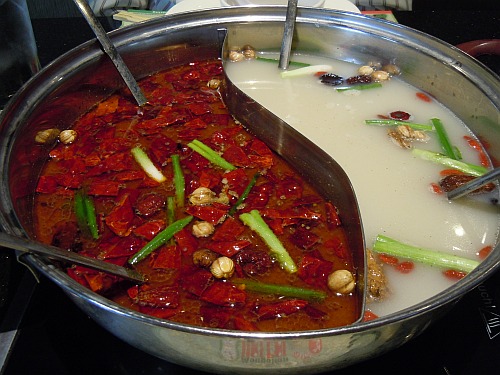 Mongolian Hot Pot
Mongolian Hot Pot
So where does the dish known as “Mongolian Hot Pot” fit into all this? Since the Mongols’ main method of cooking is to boil meats in a big pot of water, it’s understandable that this popular modern dish might be called “Mongolian.” Although the contemporary version is hardly known in Mongolia today, it’s possible that hot pots originated in northern China nearly a thousand years ago when China was ruled by the Mongol emperor, Kublai Khan. (Other historians say that hot pots date from even earlier.) A descendant of these early Mongol-Chinese hot pots, modern “Mongolian” hot pots share characteristics with Japanese hot pots (especially shabu-shabu) and with many regional Chinese versions popular all over China today. All of these are meals cooked at the table, with morsels of raw meat, vegetables, and noodles gently simmered in a well seasoned broth.
This year the “New Yorker” magazine published a rave review of the Little Lamb Mongolian hot pot restaurant in Flushing, Queens, New York—a franchise of a Chinese (Inner Mongolian) chain with some 600 restaurants worldwide. But adventurous eaters in Hawaii, California, and Texas were way ahead of those New Yorkers. For several years we’ve been eating at Little Sheep Mongolian Hot Pot restaurants that belong to another Chinese chain of 400 eateries around the world. Usually tucked away in a local Asian shopping center, these restaurants offer light, healthy, spicy meals where you do all the cooking yourself. The restaurant just makes the highly seasoned broth, slices the ingredients, plates them artistically, and brings them to the table. The rest is up to you. After all that shared work, maybe you should split the tip with them.
Do It Yourself
● For a true Mongolian barbecue, you need a sheep, a huge stock pot, a bunch of rocks, a dried dung fire, and several hungry Mongolians. Or a marmot and a blowtorch.
● For international Mongolian barbecue, restaurant-style, you need a griddle wider than your kitchen and an underpaid fast-food worker with 3-foot-long swords to cook the meal for you.
● For Japanese jingisukan, you need an ancient Mongolian warrior’s helmet and a tabletop heat source that won’t set your dining room on fire. (Okay, you can also buy jingisukan griddle sets online, too. But how often are you likely to use one?)
● So the easiest of the popular “Mongolian” dishes to make at home is the hot pot, which you can improvise with an electric work, a big skillet, or even a fondue set, plus a long list of ingredients from your nearest Asian supermarket (or available online). And if all this still seems like too much trouble, find your nearest Mongolian hot pot restaurant and enjoy your meal there. Just remember, you still have to do the cooking.




